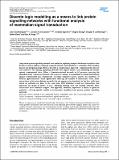| dc.contributor.author | Saez-Rodriguez, Julio | |
| dc.contributor.author | Alexopoulos, Leonidas G. | |
| dc.contributor.author | Epperlein, Jonathan | |
| dc.contributor.author | Samaga, Regina | |
| dc.contributor.author | Lauffenburger, Douglas A. | |
| dc.contributor.author | Klamt, Steffen | |
| dc.contributor.author | Sorger, Peter K. | |
| dc.date.accessioned | 2011-04-08T19:44:52Z | |
| dc.date.available | 2011-04-08T19:44:52Z | |
| dc.date.issued | 2009-12 | |
| dc.date.submitted | 2009-03 | |
| dc.identifier.issn | 1744-4292 | |
| dc.identifier.uri | http://hdl.handle.net/1721.1/62180 | |
| dc.description.abstract | Large-scale protein signalling networks are useful for exploring complex biochemical pathways but do not reveal how pathways respond to specific stimuli. Such specificity is critical for understanding disease and designing drugs. Here we describe a computational approach—implemented in the free CNO software—for turning signalling networks into logical models and calibrating the models against experimental data. When a literature-derived network of 82 proteins covering the immediate-early responses of human cells to seven cytokines was modelled, we found that training against experimental data dramatically increased predictive power, despite the crudeness of Boolean approximations, while significantly reducing the number of interactions. Thus, many interactions in literature-derived networks do not appear to be functional in the liver cells from which we collected our data. At the same time, CNO identified several new interactions that improved the match of model to data. Although missing from the starting network, these interactions have literature support. Our approach, therefore, represents a means to generate predictive, cell-type-specific models of mammalian signalling from generic protein signalling networks. | en_US |
| dc.description.sponsorship | Germany. Federal Ministry of Education and Research ('HepatoSys' and the FORSYS-Centre MaCS) | en_US |
| dc.description.sponsorship | National Institutes of Health. (U.S.) (P50-GM68762) | en_US |
| dc.description.sponsorship | National Institutes of Health. (U.S.) (U54-CA112967) | en_US |
| dc.language.iso | en_US | |
| dc.publisher | EMBO and Macmillan Publishers Limited | en_US |
| dc.relation.isversionof | http://dx.doi.org/10.1038/msb.2009.87 | en_US |
| dc.rights | Creative Commons Attribution-Non-Commercial-Share Alike 3.0 | en_US |
| dc.rights.uri | http://creativecommons.org/licenses/by/3.0 | en_US |
| dc.source | Molecular Systems Biology | en_US |
| dc.title | Discrete logic modelling as a means to link protein signalling networks functional analysis of mammalian signal transduction | en_US |
| dc.type | Article | en_US |
| dc.identifier.citation | Saez-Rodriguez, Julio et al. “Discrete Logic Modelling as a Means to Link Protein Signalling Networks with Functional Analysis of Mammalian Signal Transduction.” Mol Syst Biol 5 (2009) : 1-19. © 2009 EMBO and Macmillan Publishers Limited. | en_US |
| dc.contributor.department | Massachusetts Institute of Technology. Department of Biological Engineering | en_US |
| dc.contributor.approver | Lauffenburger, Douglas A. | |
| dc.contributor.mitauthor | Saez-Rodriguez, Julio | |
| dc.contributor.mitauthor | Alexopoulos, Leonidas G. | |
| dc.contributor.mitauthor | Lauffenburger, Douglas A. | |
| dc.contributor.mitauthor | Sorger, Peter K. | |
| dc.relation.journal | Molecular Systems Biology | en_US |
| dc.eprint.version | Final published version | en_US |
| dc.type.uri | http://purl.org/eprint/type/JournalArticle | en_US |
| eprint.status | http://purl.org/eprint/status/PeerReviewed | en_US |
| dspace.orderedauthors | Saez-Rodriguez, Julio; Alexopoulos, Leonidas G; Epperlein, Jonathan; Samaga, Regina; Lauffenburger, Douglas A; Klamt, Steffen; Sorger, Peter K | en |
| mit.license | PUBLISHER_CC | en_US |
| mit.metadata.status | Complete | |
